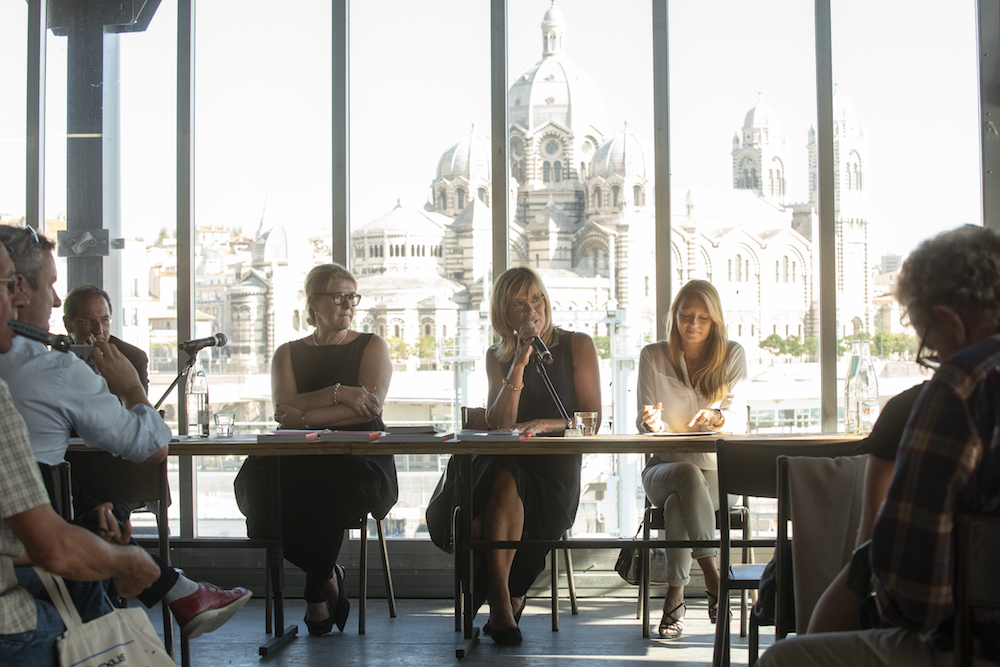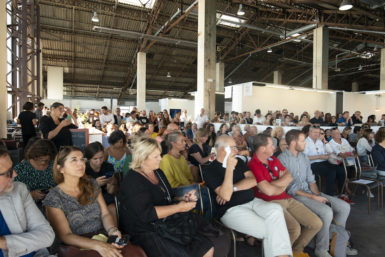[ad_1]

The press conference, with Hedwig Fijen at center.
The unrelenting Mediterranean sun beat down on Marseille during the opening of the region’s annual art fair, ART O RAMA, at J1, a onetime port hanger commanding magnificent views of the sea. As ferries passed by the windows during the first weekend of September, more than 30 galleries exhibited works ranging from affordable editions and T-shirts to art with prices that maxed out around €50,000 (about $58,100). Dealers I spoke with said they appreciated the laidback atmosphere, the chance to take in a little more sun before la rentrée, and—a rarity on the art-fair circuit—the stunning view.
But the talk at the fifth edition of the fair was not so much commerce as the contentious launch of the 2020 edition of the roving European biennial Manifesta, which will occur in Marseilles. At times, it felt like physical battle lines had been drawn in the room between the French press and the organization. Questions volleyed over from the journalists included why a Dutch architect, Winy Maas, was selected to work on the project rather than a French one. Speaking of which: “Would local curators be selected?” And, “how much of the city budget had been allocated?” Finally, “Would this be another cultural event that was parachuted into France’s second city?”
The tension was tangible, though Hedwig Fijen, who’s been Manifesta’s director for 20 years, was well-briefed and professional in her responses. She focussed on Manifesta’s ambition to understand the city and respond directly to local issues. She was pleased to announce Maas would be conducting an in-depth survey of the city in conjunction with the University of Aix-Marseille and announced that a pre-biennale architectural intervention would be part of the 2020 festivities.

The journos.
Fijen was, in short, firm. The Dutch architect, who has offices in Paris, had been appointed, she explained, because of his experience as an urban planner, and the fact that a major temporary work he completed, the Stairs to Krierion, drew serious crowds in Rotterdam in 2016. There she made a tantalizing mention of an Eiffel Tower legacy for Marseille growing out of the exhibition, plus the promise of an office where locals could pop in for a coffee and a chat at any time.
The journalists wanted hard facts on financial returns and employment for those local locals, and Fijen offered that Manifesta 12, which is running in Palermo, Italy, right now has brought in revenue for the city that is four times its original investment in the show, and that it has created jobs. The mumbling from some of the art writers present was that Palermo was a travesty, its visitor numbers of 110,000 during the first three months of its run comparing unfavorably with, say, the 615,000 who visited the 2017 Venice Biennale. Although the event has been mentioned positively by Stefan Kalmár, the director of the Institute of Contemporary Arts in London, in Frieze magazine, other critics and curators have been less generous.
Afterward, I ran into a culture worker based in the city who said that local distrust over outside cultural initiatives went back to 2013, when Marseille was the European City of Culture. This woman—who asked that her name not be used, for professional reasons—pointed out that Marseille is still a very poor city today, with an unemployment above the national average, particularly among young adults. Some areas of the city of 850,000 look very Parisian, especially where the Haussmann buildings have been cleaned. But looks can be deceptive. Commercial art galleries are few, clustering around Rue Cavalier Rose, although there are many wealthy private foundations with impressive international collections in the area. With news of Manifesta coming to town, naturally there is skepticism.
[ad_2]
Source link

